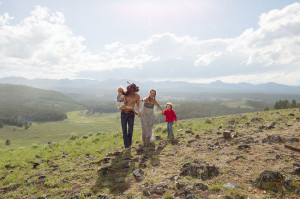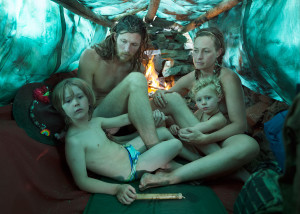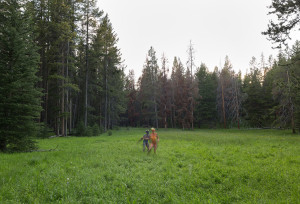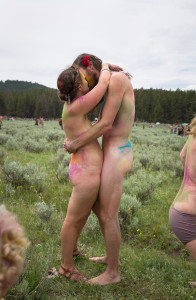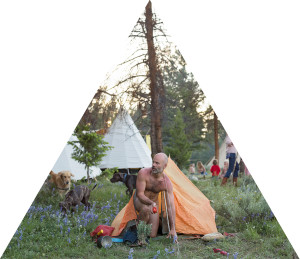Ritual Images
The Autobiographs of Ira Lippke
IN 1918, a German priest named Martin Gusinde traveled to the islands of Tierra del Fuego off the southern tip of South America. Commissioned by Chile’s Museum of Ethnology and Anthropology to study the region’s indigenous tribes, Gusinde made four expeditions over a period of six years to photograph the Selk’nam, Yamana, and Kawésqar peoples. His portraits depict the sacred ceremonies and initiation rites of the tribes—though, by that time, their traditional way of life had largely gone extinct. Decimated by smallpox, measles, and genocide, the Selk’nam were living in reduced numbers on impoverished mission settlements when Gusinde arrived. Rather than document the daily life of the imperiled tribes, Gusinde’s black-and-white gelatin prints—collected last year in The Lost Tribes of Tierra del Fuego—carefully reconstruct and re-create a vanishing cultural biome.
Though the images rely on reenactment, they retain something of the incantatory power of the old rites: Selk’nam women dressed for dancing in red ochre and decorated with ancestral motifs; Kawésqar men disguised as spirits in masks cut from bark and white paint ground from bones; Selk’nam bodies lying naked in a snowy field, enacting a passage through the underworld.
The pictures perform a surreal trick, capturing two planes of time in a single frame. As they portray the ancient rituals, they also bear witness to the real-time plight of their subjects. At a time when colonization and industrialization were wiping out many premodern cultures—and lighter, more portable camera technology made photographic evidence more widely available—Gusinde’s archive provides an important historical record and invites us to consider the role and meaning of performance in a documentary archive.
§
Across the globe, over the border of modernity and the meridian of Freud, Manhattan-based photographer Ira Lippke is pursuing his own ethnographic study of a vanishing tribe. “Taking pictures at the Rainbow Gathering is kind of frowned on, actually,” says Lippke. His studio, a fourth-floor Chelsea loft furnished with a modernist impulse, is mounted with flag-sized color prints of bearded rustics, long-haired boys, naked peaceniks splattered with vivid holi pigment—smoke-and-incense scenes from the 2013 Rainbow Gathering near Jackson, Montana. The event, which has roots in the countercultural movements of the 1970s, gathers a tent community of thousands each year on National Park land. “Anyone’s invited,” says Lippke. “As long as you have a bellybutton.”
The weeklong Gathering culminates on the Fourth of July, when the community forms a massive circle in an open field. Children wearing costumes and face paint parade into the circle behind a Native American elder, who plants a peace pole in the ground. “And then everyone prays for peace,” says Lippke. “There’s a big Om—all these voices Om-ing in the woods. It’s an amazing, beautiful expression. Then everyone comes to the middle to meet at the pole, and people bring out their drums and guitars, and it turns into a big party.”
Lippke’s father was involved in the Gathering from its early days, and Lippke spent his boyhood summers roaming the bonfires, communal kitchens, and trench latrines of the Rainbow campsite. Now in his forties, he returned to the Gathering in 2013 with his wife, their eight-month-old daughter, and a cast of friends, actors, and camera crew—part of an ongoing project to revisit and reimagine scenes from his childhood [see Plates 7 and 8].
“Most people have pictures of their childhood,” he says, “which keeps the memory alive. But we didn’t take many pictures, and then we had a fire, and we lost a lot of the photographs we did have.” The resulting photographic series, Autobiographs, relies on reenactment as well as the methods of photojournalism to depict and examine his formative experiences. “I think one of the reasons that I started this project was an attempt to put down some roots. A lot of these images are about looking for home.”
§
Lippke’s mother came from a middle-class family in Texas, and his adoptive father was raised on Long Island’s north shore—the gold coast of the Vanderbilts, Astors, Whitneys, Morgans, and F. Scott Fitzgerald’s Gatsby. His father’s family played a prominent civic role: his paternal grandfather, Charles E. Ransom, served as clerk of Nassau County and supervisor of the town of Oyster Bay. Today, local roads and a smooth stretch of sand along the bay are stamped with the family name.
Like many of their boomer peers, Lippke’s parents rejected the mainstream values of commodification and “keeping up with the Joneses.” Committed itinerants, they went west through the forests of Colorado and the mountains of Washington State, raising their family in a series of tents and a yellow step van named Blossom.
As a kid, Lippke enjoyed the freedom of Huck Finn—jumping off bridges, riding horses bareback, building bikes and racing them. He recalls the womb-like warmth of the family’s flesh-colored tents and the tribal affiliation marked by the federal-yellow paint his father bought by the gallon to brand the family’s belongings and tools—“Anything that needed painting would always be that color. We called it Blossom yellow.”
But the family’s autonomy came at a cost. Lippke remembers hitchhiking alone to school. There wasn’t always money for doctors or dentists. Not all of his siblings thrived (as Lippke’s wife points out, a boy’s paradise is a girl’s nightmare).
And the Rainbow Gathering, which the family attended every year, “has this dark side to it: drug addiction, neglect, broken families. But at the same time, there are a lot of people coming together to celebrate and pray for peace and be in harmony with nature.”
Lippke’s photographs capture this ambivalence in unreadable gestures, moments of play that tip toward violence, figures running in an open field—in play or pursuit, it isn’t clear which [see Plate 9].
§
When Lippke was in second grade, the family’s antiestablishment lifestyle met the countercultural message of Christ. “Basically, we ran out of money,” he says. “Our car was broken down, we were living in tents in the Olympic Rainforest, and it was pouring rain.” The family, whose devotional practices relied mainly on Native American prayers to the Great Spirit, began to read the Bible. “We started reading the passage in Matthew that says, Don’t worry about your life, what you’ll eat, what you’ll drink, for your eternal heavenly Father cares for you. It was just what we needed to hear.”
According to Lippke, the message of Christ kindled the family’s latent spirituality. “We were hippies in the sense of having a critical view of society and consumer culture, an openness to nature, an emphasis on love and relationships. There are so many Christian ideas that reverberate with these values.”
In Autobiographs, the details of Lippke’s childhood merge with Judeo-Christian motifs. One of his early photographs in the series depicts a family of four in a dark wooded campsite, poised for flight [see Plate 10]. Mother and father, wearing ponchos and blankets, carry two sleeping children and a candle lantern. In the lamplight, the mother turns like one of the Hebrews fleeing Egypt or Lot’s wife in the desert for a last look behind her. The title, Ransom, is a nod to the family name. It also points to the Christian doctrine of atonement and hints at Lippke’s desire to reclaim a past whose site and meaning is not secure.
“I have a memory of when my dad first came on the scene,” says Lippke, referring to his adoptive father. “It was a big deal for me, because I hadn’t really had a father for five years, and we just had an immediate love and connection.” Lippke recalls his family’s own nighttime exodus through the woods at the Rainbow Gathering, his father carrying him for miles. “I’d wake up and just feel the sense of being held. I’d see the triangle patterns of the lantern—this warm light dancing on the ground—and feel him holding me. That felt like a moment of adoption.”
For this picture, Lippke relied on actors and props and stylists to recreate the scene with detailed precision. “I wanted to approach it like a painter approaches the canvas and control everything that was happening in my frame.” He cast his younger brother Samuel in the role of his father and asked friends to fill in for the rest of the family. (Lippke’s real parents appear in the scene as two shadowy figures watching from camp chairs on the edge of the frame.) Seeking an authentic form for the past, Lippke curated the scene with a fact-checker’s zeal—“We had this exact lantern. It was this exact one.”
Though faithful to the facts, the early images in the project didn’t feel right to Lippke. During the next round of shooting, he shifted his approach. “I became less concerned with What did the tent look like? and more concerned with what was happening in our minds and souls and how did it form us and what did it feel like?” He abandoned the elaborate sets and props for a setting that naturally recalled the world of his childhood.
At the Rainbow Gathering, he began to rely on documentary methods. He made candid shots of his actors—friends Jason and Rebecca Walker in a spontaneous, loving embrace [see Plate 11]—and stumbled onto scenes that resurrected his own family life, such as a mother and child in a Blossom yellow van [see Plate 12]. (“We had a dog that looked just like that dog.”)
This way of working offered a more dynamic encounter with his subject and revealed alternate meanings in the material. Lippke’s wife, Andrea, points to Golden Triangle as a good example of the kind of “slippage” between the world of the Gathering and the world created by Lippke’s lens. In the photograph, which Lippke took on the Fourth of July, Jason and Rebecca Walker wait with the boy Isai (who plays Ira in many of Lippke’s pictures) to enter the peace circle. On Isai’s forehead, Rebecca has painted a Blossom-yellow triangle, a recurring motif in Lippke’s work. For him, the triangle recalls the flickering patterns of light cast by his father’s candle lantern. The symbol also references classical forms and religious iconography—from the pyramids and crystals of a mystic spirituality to the figure of the Trinity. The emblem has a different connotation at the Rainbow Gathering, says Andrea. “We found out later that a golden triangle on the head means that the person is dosed on acid.” Here, Lippke’s private language is translated by its public context—even as the photographer appropriates the symbol, recasting it in his own conceptual mold.
Lippke remembers when he first discovered the power of a photograph to reframe experience. He was fourteen and living in a converted school bus in Stanwood, Washington. He remembers standing in the parking lot of the public library, holding a paper sleeve of family photographs they’d just had developed. At the time, he was feeling depressed. “I remember looking at these pictures,” says Lippke, “and they enabled me to see my life in the third-person, objectively. I realized how many things I had to be thankful for.”
Lippke walked into the library and checked out a book on photography. He taught himself how to make a picture using library books and his dad’s SLR 35mm camera. When the camera broke, he spent fourteen dollars on a thrift store Yashika that he still has today.
Later, Lippke carried his DIY zeal to southern California, where he
studied the humanities at Biola University and covered tuition by working as the university photographer. He did freelance work for weddings and bands, and though he took only one photography class at Biola, he spent a lot of time in the darkroom. During the annual senior art exhibitions in the university gallery, Lippke was the only non-art major offered a solo show. “At the time, my work was all figurative,” he says, “which included some images that I wasn’t allowed to show there—nude figure studies.” Lippke, whose respectful manner and even tone disguises his dissident roots, mounted the banned pictures in a storage closet—a back-of-the-building peep-show for the cognoscenti. “It was kind of the holy of holies, the VIP room for the contraband.”
Today, Lippke continues to contemplate the body in his work, citing photographer Sally Mann as a model for the way she approaches the bodies of children and their nascent sexuality. “Our gender and sexuality—which are two separate things—are deep at the core of who we are. A lot of my memories of my childhood are dealing with that awareness.”
In How to Start a Fire, which Lippke photographed at the Rainbow
Gathering, a boy leans over a campfire, his bare chest bitten by mosquitoes. A woman dressed in body paint and a crown of leaves—a wood nymph with corn silk hair—shows him how to stoke the flame [see Plate 13]. “When I was six,” recalls Lippke, “a woman at the Rainbow Gathering taught me how to build a fire. She was naked and beautiful. She taught me that to get the fire hotter, you blow on it, which didn’t make much sense to me, because if you blow on a candle, you blow it out. It was a very loaded context.”
In the photograph, Lippke stages a meeting between present and past by casting his wife in the role of muse. In the dim light of the campfire, the two figures confront one another: the woman reclining toward the boy as though looking back through time; the boy, gripping a hatchet, his face lit by the licking flame, facing into the future.
The image has the uncanny presence of a scene from Ovid’s Metamorphoses.
Or: like a Shakespearean dream, Lippke’s wood nymphs and fair-haired sprites are the mythic motifs that appear in the clearing when the rest of the ensemble exits the stage. By narrating his past in archetypal forms, Lippke moves beyond purely personal terrain into the realm of collective memory and ancestral lore. He sees his images as linked to an oral tradition—“parents telling stories to their children around a campfire to keep their memories and traditions alive.”
Lippke pursues his exploration of collective memory further into the realm of the unconscious—experience that lies beyond language. In Family Bed, parents and children share a mattress on the floor of their van. The two children sleep—or try to—while their parents beside them make love. “Freud talks about this moment that happens when children discover their parents having sex,” says Lippke. “The primal scene. It’s a defining time in someone’s psychological development.”
For Lippke, the primal scene is loaded with feelings of desire and shame, attraction and repulsion, a sense of wonder as well as fear of the taboo. “The role of an artistic practice is just to explore things on a visceral level. I’m not attempting to do psychology with this as much as attempting to interact with how it felt for me and discover how it formed me and also offer it to other people. The discovery of sexuality is a universal experience, and it’s formative for a child.”
He remembers exploring his own awareness of the body at the Rainbow Gathering, where clothing is optional. He describes walking out of his tent naked for the first time. “I thought, Okay, this feels free. But after a while, I decided that I’m just more comfortable wearing clothes.”
Rather than reenact the moment with Isai in the role of young Ira,
Lippke decided to perform the action himself. In In the Beginning, children and dogs play around the campsite where Lippke emerges like the first man from an orange pup tent [see Plate 14].
The scene provides an encounter between the boy, as he explores the risks of self-exposure, and the man, as he revisits those feelings of freedom, self-awareness, and shame. With its suggestion of Eden (Lippke carries a piece of fruit in his hand), the image hints that at the border between original innocence and guilt stands the sudden awareness of self.
§
As a personal archive or memento, Autobiographs could be viewed as a kind of family photo album. As a work of fine art, the series explores the tradition of large-scale, narrative photography patterned by Vancouver-based photographer Jeff Wall. Wall, whose practice is rooted in the pictorial tradition of painting and in the devices of cinema, began staging large tableaux vivants in the late 1970s. One of his signature works, Picture for Women, is a densely conceived restaging of Manet’s painting Un Bar aux Folies Bergère. Wall reconceived the cabaret scene in a photographer’s studio and recast the inscrutable barmaid as a female artist’s model. In place of Manet’s high-collared dandy, Wall inserted himself in the scene; he placed a camera in the center of the frame, so that the picture interrogates both the male gaze and the predatory potential of his trade. The complex play of formal elements and art historical references in Wall’s work suggest a sly self-awareness and a dark sense of humor.
Wall’s performance-based photography has influenced artists as diverse as Philip-Lorca diCorcia, Gregory Crewdson, and the Düsseldorf group of Thomas Struth, Thomas Ruff, and Candida Höfer. Lippke admires Wall’s body of work for its variety, its meticulous construction, and its lush visual field—his phantasmagorical battlefield scene of dead Soviet soldiers, for example, or the teeming kaleidoscope of marine life in an open grave.
But if Lippke looks to Wall for formal inspiration, his own work is rooted in a different impulse. That moment in the parking lot of the public library—his experience suddenly transfigured by the photographs in his hand—suggested to him that an image might serve as a mode of contemplation: “a means of seeing the world and being in the world and experiencing the world.” Here, Lippke approaches the mystic inwardness of Minor White, for whom a photograph serves as a portal to a spiritual plane. Moving beyond the art historical play or pure pictorial seduction of Jeff Wall, Lippke sees in the photograph a medium for reflection and an affordance for spiritual discovery.
§
As a family photo album, Autobiographs invites further investigation. Its staged imitations or images caught on the fly—its actors, stand-ins, accidental resemblances and uncanny visions (the dog that looked just like his own)—suggest both an artificial past and a dreamlike present.
“Photographs furnish evidence,” Susan Sontag reminds us in her classic work On Photography. We rely on photographs to certify our experience—a picture tells us “this is real.” But a photograph can provide evidence of something other than historical fact.
Richard Avedon recalls that his own family used to pose for photographs with a dog borrowed from a friend to serve as a prop or part of the mise en scène. In Avedon’s telling, “Every one of the photographs in the family album was built around some sort of lie about who we all were.”
It’s a curious comment from a photographer who liked to stage his portraits against a blank white screen, isolating the subject from her natural environment—as though the details of the life might obscure the self. For Avedon (who once described the sitting like a one-night stand: “when the picture is done—there’s nothing left except the photograph…and a kind of embarrassment. They leave…and I don’t know them…the photographs have a reality for me that the people don’t”), the photograph certifies only the fact of itself and the reality conjured by the photographer at the moment he clicks the shutter.
In the case of the adopted dog, the photograph furnishes evidence of the sort of family the Avedons imagined themselves to be. Annexing the form and appearance of an ideal, they claimed an enviable authorial control—as Lippke, with his camera, enjoys an agency not afforded to him by his parents’ experiment in better living.
Sontag here alludes to the enfranchising potential of the camera: “As photographs give people an imaginary possession of a past that is unreal, they also help people take possession of a space that is insecure.” For Lippke, whose past was one of movement and flux, the photograph offers to fix the body in its line of flight. (Think of the early motion studies of Eadweard Muybridge or Étienne-Jules Marey, whose images of airborne athletes and racehorses made legible the galloping world.)
Further, Sontag reminds us that the family album is itself a document founded in disruption, dislocation—even dissembling. “Photography becomes a rite of family life just when, in the industrializing countries of Europe and America, the very institution of the family starts undergoing radical surgery. As the claustrophobic unit, the nuclear family, was being carved out of a much larger family aggregate, photography came along to memorialize, to restate symbolically, the imperiled continuity and vanishing extendedness of family life. Those ghostly traces, photographs, supply the token presence of the dispersed relatives.” In other words, when the family dog is borrowed, when the family name is inherited through adoption—when the tribal rites have been eroded by a campaign of extermination and resettlement—the photograph offers a ritual and a totem to ratify family bonds.
§
Lippke left the west coast for New York after college and opened his photography studio in 1993. Today, he employs four full-time photographers, including his friends and collaborators Jason and Rebecca Walker. Though his team has worked in fine art, photojournalism, and fashion photography, the studio’s bread-and-butter is weddings. In venues like the grand ballroom of the Plaza Hotel or remote locations like the Cyclades Islands, Lippke documents events where you might spot a member of the cast of Girls or see Ivanka Trump swiveling on the dance floor. Towers of orchids, centerpiece triumphs, custom chuppahs, crystal, couture—the weddings are polished with the sheen of a luxury brand.
Lippke’s wedding work is a favorite of stylish glossies like Town and Country, Martha Stewart Weddings, and Wedding Style. He’s received awards from the Wedding Photojournalist Association and Brides magazine, which recently named him one of “The Wedding Photographers Every City Bride Should Know About.”
For Lippke, his wedding photography isn’t so different from the fine art photography of Autobiographs: “It’s the same subject matter. It’s humans. It’s family. It’s love and gender and sexuality and the spiritual world. What I’m doing as a photographer is documenting and exploring formative events in people’s lives and telling stories.”
He’s right, of course—though the scenes at the altar and around the campfire share more than subject matter. The weddings of New York’s elite are carefully choreographed rituals, like the planting of the peace pole at the Rainbow Gathering or the annual Avedon family shoot. Though the brides might favor photographs with a documentary look, the images also follow a careful script: monogrammed initials, gleaming cufflinks, gilded bridal suites, the father-daughter dance.
What makes these pictures stirring isn’t the white-capped happiness of bride and groom or the camaraderie of the wedding party, but the thing that stands just outside the frame. Each image of ritualized love, speared like a butterfly on the shaft of a pin, is made poignant by what’s missing: the sense of movement and change over time. Emblems of stability, longevity—armored affluence—these wedding rites and their images defer the changes wrought by aging, denial, or loss. They are perfect specimens of celebration—if not love, which happens over the rippling surface of time or in wooded clearings where play sometimes looks like pursuit, where predator and prey might appear to be lovers.
§
Yes, says Lippke, the life he’s built in New York looks different from that of his parents. He’s attracted to the financial security he never had as a kid. He’s drawn to the details of fine craftsmanship that were missing from his father’s slapdash structures of plywood and paint. He feels the deficit of his family’s “laissez-faire approach to education” and is drawn to the cultural education found in New York. He’s made different choices than his mom and dad. (“Jonathan Franzen would call it a correction,” he says.)
In important ways, however, he’s maintained a connection with the past. Recently, he moved with his family from Williamsburg, Brooklyn, to a wood-shingled colonial home on Long Island near the beach that bears his grandfather’s name. Adopted as a boy, Lippke has adopted two young children with his wife. He sees his own goals as consonant with those of his parents: “A lot of what I’m doing is the same thing. There might be some nice chandeliers—actually, I think of it as a sculpture,” he says, pointing to the Lindsey Adelman lamp that hangs from the ceiling—“but there’s the continuation of their search for relationships and meaning.”
As he continues to extend his autobiographical work, he’s plotting his next set of scenes; he’d like to document the moment of his family’s conversion to Christianity in the Olympic rainforest. “This will be like camping out in the rain, looking for food in the woods, trying to catch fish, foraging for nettle and mushrooms. It’s going to get even dirtier,” he says. (“How is that possible?” his wife wails. “It can’t get dirtier!”)
At a time when digital technology has shifted the meaning of photorealism (Photoshop makes it possible to assemble a photorealistic image pixel-by-pixel; Jeff Wall, for example, now constructs a single image from over a hundred shots), Lippke’s insistence on verisimilitude might seem anachronistic or naïve. But his planned shoot in the rainforest, cramped in a van with two small children, a crew, and their families, reveals the performative spirit of the project. For Lippke, the work of creating a scene—the intimacy and vulnerability it demands—is as valuable as the photograph it produces. “Art is a verb,” he says, “rather than only a noun.”
The encounter between photographer and subject—and later, between the work and the viewer—has the dynamic power to inaugurate new modes of existence. Like the vows recited by a bride and groom or the vanishing rites of an indigenous tribe—like the recitation of Mass or myth, the ritual brings into being the thing it describes.




